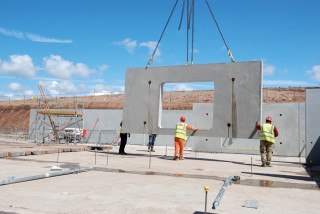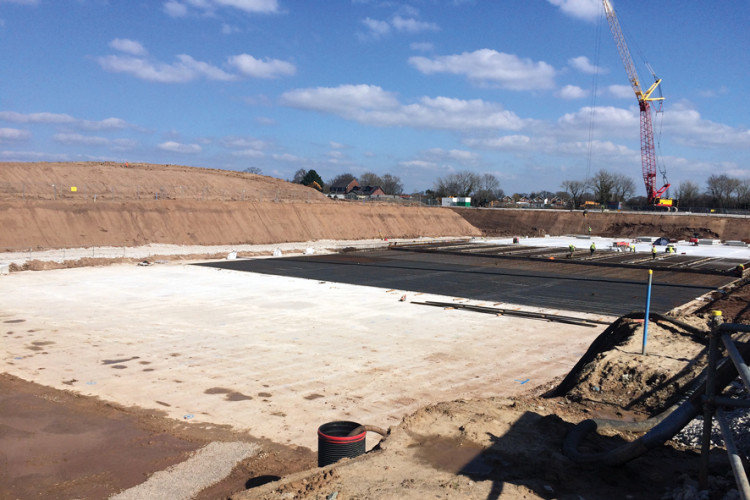The Mersey isn’t best known for being the cleanest of England’s rivers; in the mid-1980s its estuary was declared the most polluted in the UK. But today it’s cleaner than it has been for more than a century – and it’s going to get even cleaner.
United Utilities is currently undertaking a massive programme of works to improve wastewater treatment and the sewer network in the Mersey catchment area, including an ambitious £200m extension (now nearing completion) to Liverpool’s wastewater treatment works at Sandon Dock. Before this facility was built in the late 1980s, crude sewage was discharged directly into the river. Further upstream other, equally impressive, improvement work is also underway. And with further investment by United Utilities in its sewer network the clean-up is set to continue.
United Utilities and its framework contractor KMI (a joint venture between Kier Infrastructure, J Murphy & Sons, Interserve Construction and consulting engineer Mouchel) are currently engaged in several large-scale engineering works, not least the installation of what is believed to be the largest precast concrete detention tank ever seen in England.
United Utilities project manager Eric Hepworth says: “The detention tank is being built just off the Knowsley Expressway, in Runcorn, and will vastly increase the capacity of the local sewer for safely retaining storm water, which might otherwise have ended up flowing into the River Mersey via Ditton Brook.” The rectangular detention tank will measure 140m by 43m – covering a substantially bigger area than a football pitch - and will be capable of storing the equivalent of 36 million pints of water. “Over the past few years we’ve created extra storm storage in our sewer network across the Merseyside area. This will help improve the River Mersey by reducing the number of times the local sewer system overflows in heavy rains,” says Hepworth. This project – officially known as the HAL0037 Ash Lane UID (unsatisfactory intermittent discharge) scheme – is one of a number of jobs associated with the overall AMP5 Change Protocol C (CPC) Knowsley, Huyton and Widness (KHW) programme of works. Besides HAL0037, the AMP5 KHW CPC Catchment UID programme also includes another six jobs, five of which, now complete, comprised Phase 1. Phase 2 involves construction of 23,500m3 of additional storm storage at Huyton WwTW, now also complete, leaving the Ash Lane UID as the last scheme to be delivered in the KHW programme.
The existing Ash Lane CSO is a stilling pond facility located in a field adjacent to Ash Lane, Widnes. During heavy rainfall, spill flows discharge through a 1,750mm- diameter pipe to Ditton Brook, about 680m downstream of the chamber. There is currently no storage at the site and so flows pass through the CSO chamber and over a spill weir into the watercourse. The aim of the current project is to provide a means of storing these flows temporarily and allowing silt and other contaminants to settle before the clean water is discharged under controlled conditions. Work started with tree removal and the erection of newt fencing in January 2014 and continued with construction of a new site access road in October. The project was completed, on time, in September.

The original scope of the project was to have two CSO screens capable of screening up to 2,800 litres/sec each. The new detention tank would have 17,000m3 of storage and an integral flushing system to clean the tank on emptying. The tank itself was envisaged as two 35m-diameter diaphragm wall structures each about 20m deep. A set of duty/standby storm return pumps would return flows downstream of the new CSO chamber once storm flows subsided while a smaller “scavenger” pump was to be provided within the detention tank so that the tank could be fully drained.
Building such large structures on site is time- consuming and vulnerable to delays due to poor weather. Additionally, there was a potential risk of flotation of the detention tank due to upward ground and water pressure. Various options were considered – including using thicker walls and floors and pinning the structure down with anchor piles. But after an extensive value engineering exercise by KMI, an alternative design employing a single detention tank assembled using precast concrete components was chosen. This avoided the flotation problems by using a shallower tank that covered a much larger footprint. “The contractor tendered to three or four companies and chose a solution put forward by Kijlstra,” says Hepworth.
Kijlstra, headquartered in the Netherlands, specialises in making precast concrete products for the water industry. A relative newcomer to the UK (it first established an office here in 2008) the company is steadily changing perceptions in the civil engineering and utilities sector with its time- and cost-saving designs. Earlier this year it opened its first UK factory, located in Henlade, Somerset (see TCI Magazine, February 2015).
Kijlstra’s off-site solutions ticked all the right boxes for United Utilities, says Hepworth. “We have a ‘design for manufacture’ strategy at United Utilities and a team that is constantly looking for innovative solutions,” he explains. “This includes - but is by no means confined to - precast concrete,” he adds. “Off-site manufacture cuts the amount of work done on site, which is safer and quicker,” explains Hepworth, “and quality and finish is also much better because it’s made in factory conditions”.
Other off-site solutions were also considered, admits Kijlstra’s project manager Steve Gainsley. “KMI were very interested in a plastic tank system which consisted of several very large diameter pipes, but there were concerns over the performance of this design and the engineer threw it back.”
The concrete tank is truly monumental in scale: buried under 3m of soil, it has internal dimensions of 135m x 42.1m and is 3m in height. It has an in-situ base set at a fall of 1:200 and is divided internally into eight 5m-wide channels which are easily cleaned by the flushing mechanism. The external walls are assembled using Kijlstra’s precast concrete panels measuring 6m wide and 300mm thick. The roof also comprises precast panels measuring 5m x 3m and again 300mm thick with an additional 200mm-thick layer of in-situ concrete on top.

Kijlstra also supplied the precast CSO chamber and return pumping station along with the tank itself. “One of the innovations that impressed the client was that we presented to them with the flushing system partially factory-fitted,” he says. When in use, the tank will start collecting excess flows when the rate exceeds 274 litres/sec. The flow is screened and spills into the pumping station from where it spills in sequence into the flushing chambers at the top of the detention tank. When the flushing chambers are full, the flow spills over the weir in the pumping station and down to the bottom end of the tank which then fills until the storage volume is reached. At this point the spill weir level in the CSO chamber is reached and the flows discharge to the existing overflow pipe into Ditton Brook. The tank and its ancillary components were installed by the beginning of September; the considerable volume of soil excavated to accommodate the tank is now being reused on site for landscaping purposes.
For Hepworth, who has 40 years’ experience in the water industry, the use of precast concrete for this type of structure continues an ongoing trend in the industry. “I’ve worked with precast concrete many times before – it’s not new. But the biggest change I’ve seen in the industry is a massive improvement in health, safety and welfare. Offsite construction is much safer and I think that’s driving the trend. Precast has always been there, but this takes it to a new level.”
Mersey Makeover
The catchily-named “AMP5 KHW CPC Catchment UID” is just one of a number of projects associated with the “Liverpool Programme”, the centrepiece of which is the extension to the Liverpool Wastewater Treatment Works.
The new £200m extension, at Wellington Dock, will serve around 600,000 Liverpudlians, taking away their sewage and treating it before returning clean water to the river. The completed plant will be able to cope with 11,000 litres of waste a second.
Work on the extension to the existing treatment works at neighbouring Sandon Dock started in autumn 2011. The scheme, which is due to be up and running by spring 2016, completes a sequence of projects which began in the mid-1980s.
Water quality was massively improved with the construction of the treatment works at Sandon Dock in 1989. A new 29km sewer was built from Crosby to Speke, carrying the city’s wastewater to Sandon Dock. Before this was built, 26 outfalls would regularly discharge sewage directly into the Mersey.
Over the past 30 years, the water quality in the Mersey Estuary has steadily improved. Today, fish species including salmon, trout, lamprey and dace have re- colonised the river, attracting other wildlife including otters and grey seals.
As part of the new improvements, a new, longer outfall has been installed and is already being used. The 250m- long outfall disperses the water further into the middle of the estuary and away from the banks of the river.

This article first appeared in the October 2015 issue of The Construction Index magazine. To read the full magazine online, click here.
To receive you own hard copy each month in traditional paper format, you can subscribe at
http://www.theconstructionindex.co.uk/magazine
Got a story? Email news@theconstructionindex.co.uk



